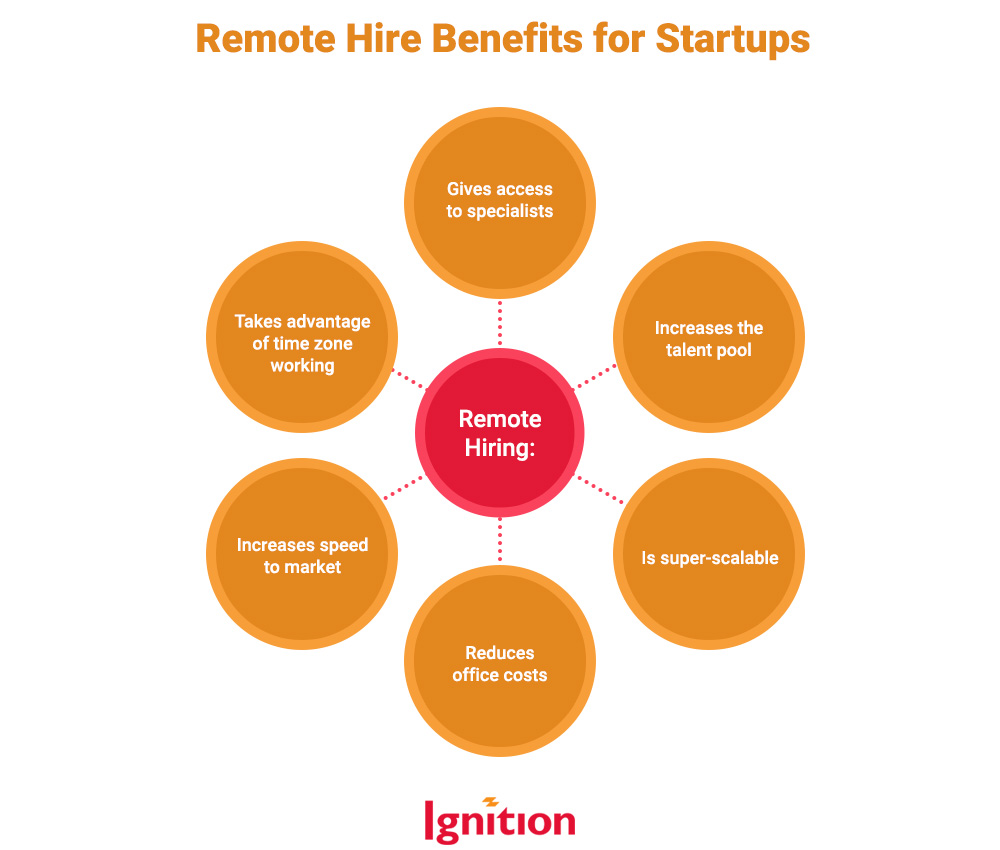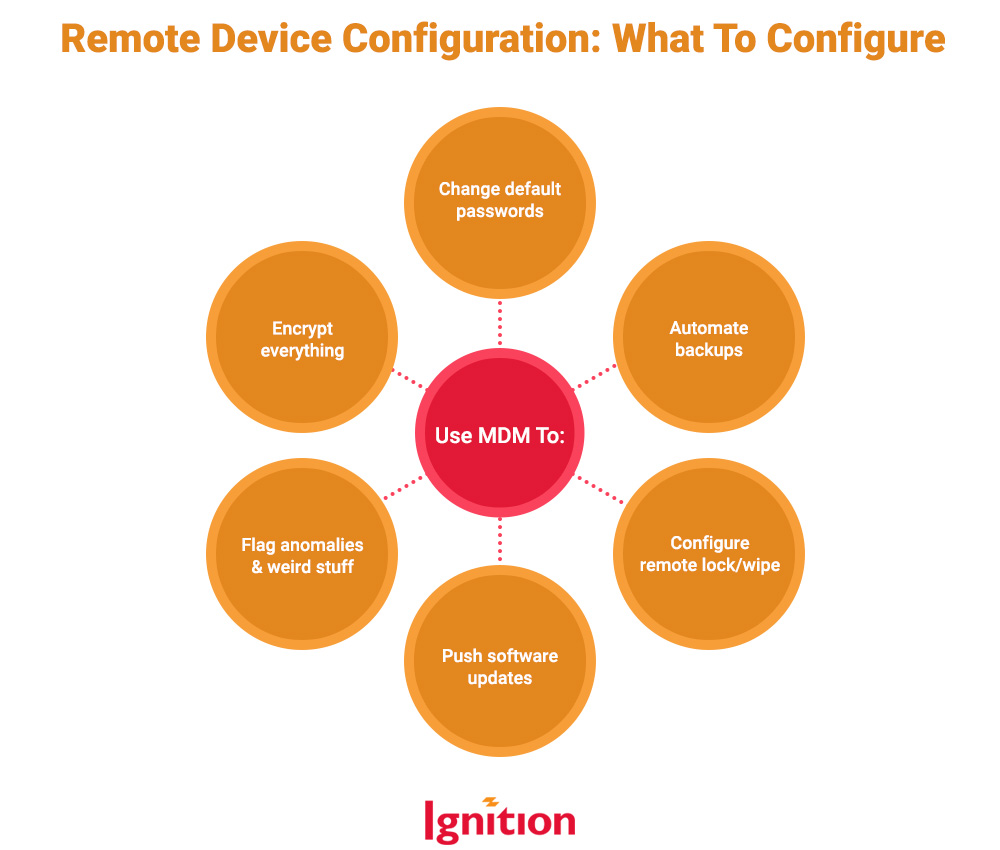Startups like yours are at the pointy end of innovation. You’re busy disrupting, leveraging, or pivoting on All The Things. Go you! But you can only disrupt, pivot, etc., properly if you’re agile enough to scale up – fast and fairly furious. And what do you need for agility? A super tight remote onboarding game, that’s what.
Ramping up your headcount in under 20 minutes probably sounds like a nightmare, but here are five remote onboarding tips for startups that’ll keep the screaming to a minimum.
Wait Up, Why Would I Want To Hire Remotely?
Seriously, why would you not? Remote working isn’t just a fun, post-pandemic option. It’s a positive benefit for startups that fosters a bumper crop of speed and talent for cost savings (bonus!) and minimal intellectual effort, as you’re already busy with disruptive pivots. Look at the pretty picture, and you’ll see what we mean:

Convinced yet?
OK, I’m In. Hit Me With Those Five Remote Onboarding Tips.
Don’t threaten me with a good time – let’s go!
1. Get Yourself A Remote Onboarding Policy
Policies, schmolicies, you say? Nope. Remote onboarding policies might not be sexy, but they’re the foundation for a consistent, streamlined, secure, and error-free onboarding experience for your new hires. Oh, and they’ll frame your corporate standards and requirements for onboarding, too. Policies require some heavy thinking and should cover, at a minimum:
- Purpose, goals, and objectives. What do you want out of remote onboarding? What does success look like?
- Roles and responsibilities. Who does what, and when? What are the responsibilities of HR, IT, team leads, etc.? How will you communicate?
- Process. No guesswork allowed. What’s the step-by-step process for onboarding? How will you know if it’s successful (or not)?
- IT and tech requirements. What will you need for secure, seamless onboarding: hardware, software, security frameworks, protocols, etc.? How will you ensure data security?
- Standards and expectations. Quality onboarding means knowing what’s acceptable and what isn’t, e.g., the ideal time-to-onboard.
Your policy is the source of All Remote Onboarding Wisdom.
2. Get Mobile Device Management
Mobile device management (MDM) is your go-to central control mechanism for managing remote onboarding (and offboarding). It gives your new hires the tools and access they need to get straight into their jobs, but without sacrificing security or consistency. It’s how you streamline and simplify the technical onboarding process, which, in turn, creates a smooth and positive experience for your newbies, which, in more turn, makes them believe they’ve landed jobs that don’t suck.
3. Become Besties With Your HR Person Or Whoever Knows What Your New People Need
MDM automates onboarding, and one of the joys of onboarding automation is superfast provisioning, but this only happens if you’ve preconfigured MDM with the responsibilities and access permissions for each type of role.
First, you gotta know who you’re recruiting and what they need, so power up those comms with the decision-makers to create an awesome onboarding checklist. Second, you gotta click on those MDM switches to create a buffet of:
- User segmentations, roles, and responsibilities.
- Role and seniority profiles.
- Role-based access permissions and security policies.
Basically, you’re deciding ahead of time what kind of person gets what kind of access to all the shiny corporate stuff. Once you’ve preconfigured everything, you’re good to go. (Sounds difficult, you say? We can help.)
4. Enjoy Onboarding Automation in Two Innovative Flavors
Onboarding automation comes in two flavors: zero-touch onboarding and conditional access. Use zero-touch onboarding for corporate-owned devices and conditional access if you have a BYOD policy.
And listen, just because we use the phrase “automated onboarding,” it doesn’t mean the human element has been squeezed out of the process. It means that the human error element has been squeezed out. This is a good thing. Automated onboarding leverages technology to:
- Provision new people with all the role- and seniority-based apps, accounts, access, and files they need – quickly and without muck ups. (See Tip 3).
- Eliminate the tedious need for you to prepare, provision, and send devices to new hires.
- Enroll new people securely onto the corporate network.
- Manage and automate new hire communications and induction workflows, eliminating repetitive administrative burdens for HR and managers.
- Create a consistent, secured, and standardized onboarding methodology that checks all the compliance boxes.
5. Configure for Security Like You Mean It
If you’re doing remote onboarding, it means that there’s a ton of devices and people floating around out there with the potential to screw you over, data security-wise. Whether out of carelessness, ignorance, frustration, or your organization’s weirdass culture, those people aren’t your problem right now. Your problem is to configure remote devices so that your new people don’t accidentally welcome a dose of ransomware or equivalent yuk into your baby startup.
MDM’s your Holy Grail for All The Device Configuration, so make sure you tighten those security vulnerabilities and nix slippery attack vectors with a hefty dose of sensible configuration.
Here’s what to include:

Once you’ve configured to insane levels, you can’t leave it there. You’ll need a human at MDM basecamp to monitor any red flags and take action on the same. (Don’t got extra humans for this? Ahem, we do.)
Remote Onboarding Isn’t Scary, So Come On In
You don’t have to be scaling hard to benefit from the delights of remote onboarding. It’s good for organizational changes, too, like introducing a work-from-home or hybrid model for your existing teams or offering a Choose Your Own Device policy.
Want to find out how it might work in your startup? We don’t know how to tell you this, but our remote onboarding services are what makes our startup clients literally purr. Oh, look: we did know how to tell you! Anyhoo, give us a call because now you’ve got five remote onboarding tips for startups in your head, and we want to tell you five more. Clickbait alert: No. 4 will shock you. We’ll stop now.
Ignition is Silicon Valley’s best (and friendliest) IT security, compliance, and support team. Contact us now – chatting about IT support and cybersecurity is our favorite thing to do!

